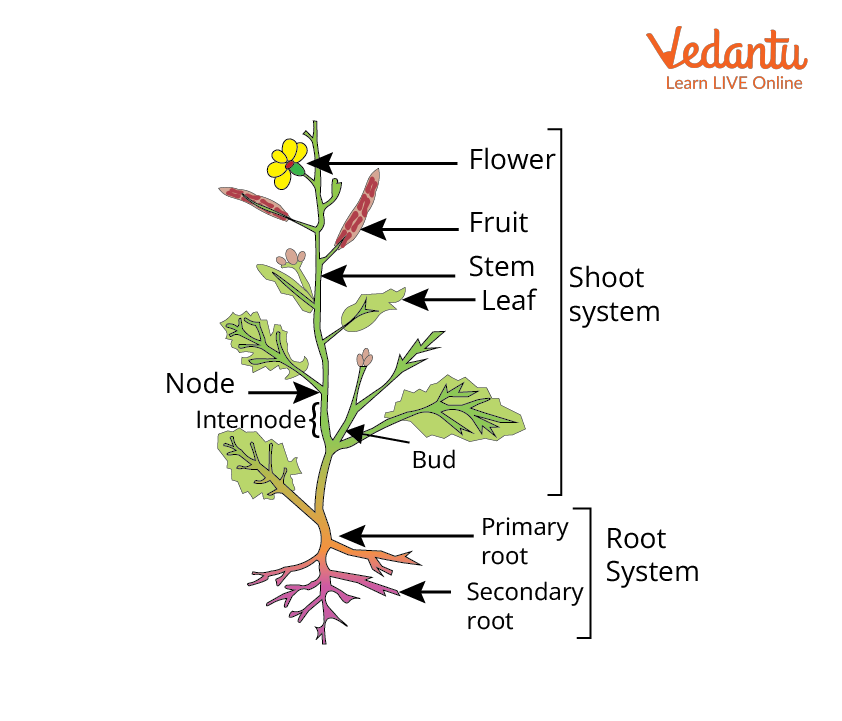




Introduction to Morphology of Flowering Plants
The study of morphology in plants involves understanding the form and structure of plants, particularly flowering plants (angiosperms). Flowering plants are essential to the ecosystem because they play a crucial role in producing oxygen, food, and other resources necessary for life on Earth. Flowering plants exhibit various structures such as roots, stems, leaves, flowers, fruits, and seeds that contribute to their growth, survival, and reproduction. This guide provides an in-depth exploration of the morphology of flowering plants, from the root system to seed development.

Root System of Flowering Plants
The root system is an essential part of flowering plants. It anchors the plant to the soil and plays a significant role in absorbing water, minerals, and nutrients from the soil. There are three main types of root systems in flowering plants
Functions of the Root
Anchorage- Stabilises the plant.
Absorption- Takes in water and nutrients.
Storage- Stores energy in the form of starch.
Transportation- Conveys water and minerals from soil to the stem.
Shoot System- Structure and Function of the Stem
The shoot system consists of the stem, branches, leaves, and flowers. The primary function of the shoot system is to support the plant, transport nutrients, and help with reproduction. The stem grows upward and bears leaves, flowers, and fruits. It also serves as a conduit for water, minerals, and food produced by the leaves.
Characteristics of Stems
Support- The stem provides structural support to hold leaves, flowers, and fruits.
Transport- Stems transport water, minerals, and sugars between the roots and other parts of the plant.
Growth- The stem allows the plant to grow taller and produce more leaves and flowers.
Functions of the Stem
Support- Provides structure to the plant.
Transport- Carries water and nutrients from roots to leaves and flowers.
Growth- Helps in vertical growth and branching.
Leaf Morphology- Types and Functions
Leaves are the primary sites for photosynthesis, the process by which plants convert sunlight into food. They also play a key role in gas exchange and transpiration, the process of releasing water vapor into the atmosphere.
Basic Parts of a Leaf
Leaf Blade (Lamina) - The flat, green part of the leaf responsible for absorbing light.
Petiole - The stalk that attaches the leaf to the stem.
Leaf Base - The part where the leaf attaches to the plant.
Functions of the Leaf
Photosynthesis- Converts sunlight into energy.
Transpiration- Regulates water loss.
Storage- Stores nutrients and water.
Flowers- Structure and Reproduction
Flowers are the reproductive organs of angiosperms and are crucial for pollination. A typical flower consists of four main parts - the calyx (sepals), corolla (petals), androecium (stamens), and gynoecium (carpels). These parts work together to ensure successful fertilisation and seed formation.
Pollination occurs when pollen is transferred from the anther to the stigma, leading to fertilisation and the formation of seeds.
Reproduction in Flowering Plants
Pollination is the process in which pollen is transferred from the anther (male) to the stigma (female) of a flower. This can be facilitated by wind, insects, birds, or other natural elements. After fertilisation, the ovary of the flower develops into a fruit, and the seeds contained inside grow into new plants.
Fruits and Seed Development in Flowering Plants
Fruits are the matured ovaries of flowers, and they contain seeds. Seeds are produced as a result of fertilisation and are crucial for the reproduction of the plant. The development of fruit and seed involves several stages
Fertilisation- After pollination, the male and female gametes (pollen and ovule) fuse to form a zygote, which develops into a seed.
Fruit Formation- The ovary of the flower grows and ripens into a fruit, protecting the seed inside.
Seed Dispersal- The fruit helps disperse the seed to new locations where it can grow into a new plant.
Seeds are formed after fertilisation, and they contain the embryo that will grow into a new plant.
Essential Study Materials for NEET UG Success
FAQs on Complete Guide to Morphology of Flowering Plants
1. What are the main parts of a flowering plant?
The main parts include the root, stem, leaves, flowers, and fruits.
2. What is the function of the root system?
The root system anchors the plant, absorbs water and nutrients, and stores food.
3. How do stems help plants?
Stems provide support, transport nutrients, and aid in the growth of branches and leaves.
4. What is the role of leaves in photosynthesis?
Leaves absorb light and convert it into chemical energy, providing food for the plant.
5. What are the different types of flowers?
Flowers are classified as complete or incomplete, depending on the presence of all reproductive parts.
6. What is the process of pollination in plants?
Pollination is the transfer of pollen from the male anther to the female stigma, leading to fertilisation.
7. What types of fruits do flowering plants produce?
Simple, aggregate, and composite fruits are the three main types.
8. What is a dicotyledonous seed?
A dicotyledonous seed has two cotyledons and is found in plants like beans and peas.
9. What are adventitious roots?
These roots arise from any part of the plant other than the radicle.
10. How do flowers help in reproduction?
Flowers facilitate reproduction by producing pollen and seeds, ensuring the survival of the species.























